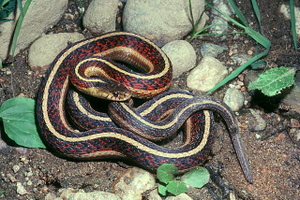In some areas, common gartersnakes spend the cold winter months completely submerged in water. Submerged snakes retain more body water and conserve more stored energy than do snakes in dry sites. At the low temperatures of hibernation, the snake’s metabolic rate is very low, so oxygen needs can be met even while the snake is submerged and unable to breathe air.
Photo Credit: Geoffrey A. Hammerson
Thamnophis sirtalis
Common Name: common gartersnake
Other Common Names: common garter snake, eastern garter snake, red-sided garter snake
Animal Guild: Reptile
Class > Order > Family: Reptilia > Squamata > Colubridae
What does the species look like?
The coloration varies geographically and is difficult to characterize succinctly. These snakes have 19 dorsal scale rows at mid-body, a pale lateral stripe on each side on the 2nd and 3rd scale rows (also on row 4 in subspecies annectans of Texas-Oklahoma), 7 scales on each upper lip, 1 preocular (scale in front of eye), 3 postoculars (scales behind eye), scales with a ridge down the center (keeled) on the back, and an undivided anal scale (covers vent). Adult total length is usually 16-26 inches (41-66 cm), with the maximum around 52 inches (131 cm). Newborns are around 5-7 inches (12-23 cm) in total length. This species differs from other coexisting garter snakes by the following combination of characteristics: lateral stripe confined to 2nd and 3rd scale rows (except in annectans), seven scales along each upper lip; tail less than 27% of total length, and 19 scale rows along the back and sides in the mid-body region.
Where is the species found?
States & Provinces
AB, AL, AR, BC, CA, CO, CT, DC, DE, FL, GA, IA, ID, IL, IN, KS, KY, LA, MA, MB, MD, ME, MI, MN, MO, MS, MT, NB, NC, ND, NE, NH, NJ, NM, NS, NT, NV, NY, OH, OK, ON, OR, PA, PE, QC, RI, SC, SD, SK, TN, TX, UT, VA, VT, WA, WI, WV, WY
Distribution
The broad range includes much of North America, from southeastern Alaska, British Columbia, Alberta, southern Northwest Territories, northern Saskatchewan, central Manitoba, Ontario, central Quebec, and the Maritime Provinces to southern California, central Utah, northeastern Colorado, New Mexico and Chihuahua (disjunct), Texas, the Gulf Coast and eastern seaboard, and southern Florida.
Throughout the range, common gartersnakes inhabits a wide range of aquatic, wetland, and upland habitats; habitat preference exhibits rather pronounced regional differences (e.g., east vs. west). In some regions, such as much of eastern North America, these snakes are decidedly terrestrial and range far from water. In other areas, such as the Rocky Mountain region, they are mostly confined to riparian corridors.
General Phenology and Life History
Most activity occurs from about March or April through October in the north and at higher elevations; the active season is longer in the south (year-around in southern Florida). Common gartersnakes are active both day and night in most of the range; nocturnal activity often occurs during hot weather. When inactive, theses snakes are underground, in or under surface cover, or in other secluded sites. In some areas in the northern part of the range, common gartersnakes make long migrations between winter hibernacula and summer range. In much of the range, mating occurs primarily in spring, just after emergence from hibernation, though possibly to a limited extent also in late summer. Adult females give birth usually in July or August but earlier in the south and as late as early October in the north. Litter size averages about 13-26 but varies geographically (generally larger in the east than in the west); the largest females tend to produce the largest litters.
Which phenophases should I observe?
Do you see/hear...?
Activity
Individuals on land More...
For abundance, enter the number of individual animals observed in this phenophase.
Individuals in water More...
For abundance, enter the number of individual animals observed in this phenophase.
Feeding For abundance, enter the number of individual animals observed in this phenophase.
Development
Young individuals For abundance, enter the number of individual animals observed in this phenophase.
Dead individuals For abundance, enter the number of individual animals observed in this phenophase.
What do these phenophases look like?
There is currently no photoguide available for this species. If you'd like help us create one, use the guidance document and species template provided here . Then send it via email to education@usanpn.org when it is complete.
